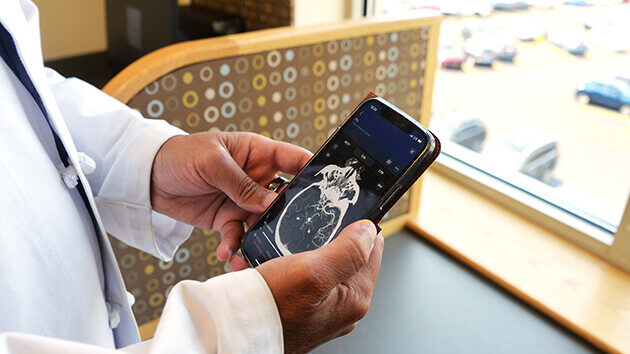Artificial Intelligence Benefits Stroke Patients

It wasn’t how Joseph and Rosemarie McFadden expected to spend their 41st anniversary. Awoken to find Joseph moaning painfully, it didn’t take Rosemarie, a nurse, long to recognize he was experiencing a stroke.
She dialed 911 and waited for an ambulance to arrive to transport him to Glens Falls Hospital.
Although the couple’s goat farm in the Adirondack town of Johnsburg is 77 miles from Albany Medical Center, the closest Comprehensive Stroke Center, innovative software throughout the Albany Med Health System helped ensure that Joseph received the care he needed as quickly and efficiently as possible.
It’s been one year since the Health System was the first in northeastern New York to apply the Viz.ai computer-aided triage system to help facilitate early access to the most advanced stroke care for patients at each of its four hospitals, including Albany Medical Center, Columbia Memorial Health, Glens Falls Hospital and Saratoga Hospital.
When a patient who is suspected of having a stroke arrives at the hospital, a CT angiogram is performed to assess blood flow to the brain. When the software detects a large vessel occlusion (LVO)—a type of stroke caused by blockage to one of the major arteries and having a greater risk of death or long-term disability—stroke specialists across the System are alerted immediately on their phones, allowing them to chat through the cloud-based platform in real time to plan for appropriate treatment or transfer of care to Albany Medical Center.
Alexandra Paul, MD, assistant professor of neurosurgery at Albany Medical Center, received the alert on her phone when the software detected a LVO on Joseph McFadden’s CT angiogram at Glens Falls Hospital.
“We determined that Joseph was a candidate for endovascular intervention. Our residents immediately called the Access Center to facilitate his transport to Albany Medical Center and we began to prepare for his arrival,” she said.
Dr. Paul is one of four endovascular neurosurgeons at Albany Medical Center trained to perform mechanical thrombectomy—the “gold standard of stroke treatment”—to remove clots and restore blood flow to the brain, increasing the likelihood of a better quality of life after stroke.
“The software eliminates a lot of delay inherent to the system,” explained Dr. Paul. “We’re no longer waiting for a radiologist to read the scans and alert the ER team who then notifies the Access Center, who then notifies the neurosurgery team, who then has to wait for the scans to be uploaded and reviewed. It’s now instantaneous.”
Rosemarie, who accompanied her husband in the ambulance to Albany Medical Center, was amazed by how quickly after his arrival that Dr. Paul was able to complete the procedure to relieve the blockage.
“Between the time I found him to the time Dr. Paul was done, it was about six hours,” she said. “From the Emergency Department at Glens Falls Hospital, to radiology, to the neurosurgeons at Albany Medical Center, it was truly miraculous how quickly they acted.”
The 73-year-old regained his movement within the next 48 hours and is now back at work tending to their farm. Dr. Paul says the outcome would likely have been different had he not received care so quickly.
“Every second counts with a stroke. It’s likely that if a patient is not cared for in time, they are no longer a candidate for the procedure and we are unable to reverse their stroke symptoms.”
According to research conducted by Nicholas Field, MD, a PGY-7 neurosurgical resident, transfer times for stroke patients to Albany Medical Center form partner hospitals using Viz.ai software have decreased by an average of 37 minutes.
“This time savings can be the difference between disability free life or stroke,” said Dr. Paul.
“The availability of the new stroke software here at Glens Falls Hospital has been a game changer for our physicians and patients now collaborating with our colleagues across the System,” says Jon Braiman, MD, stroke medical director at Glens Falls Hospital. “We are identifying candidates for acute stroke intervention more efficiently and quickly which means better outcomes.”
Given the software’s success, the System is in the process of rolling it out to other community hospitals this fall.
